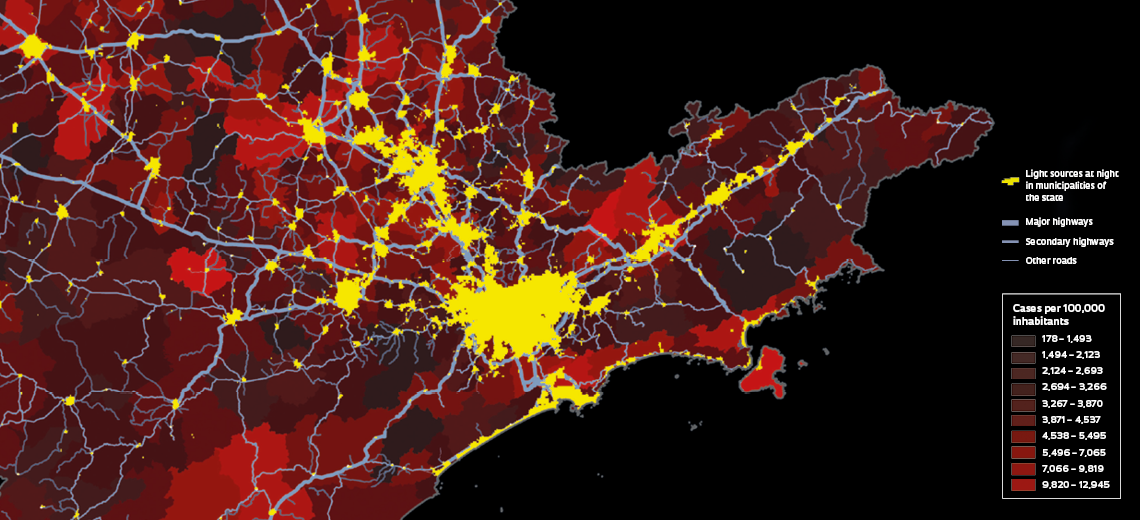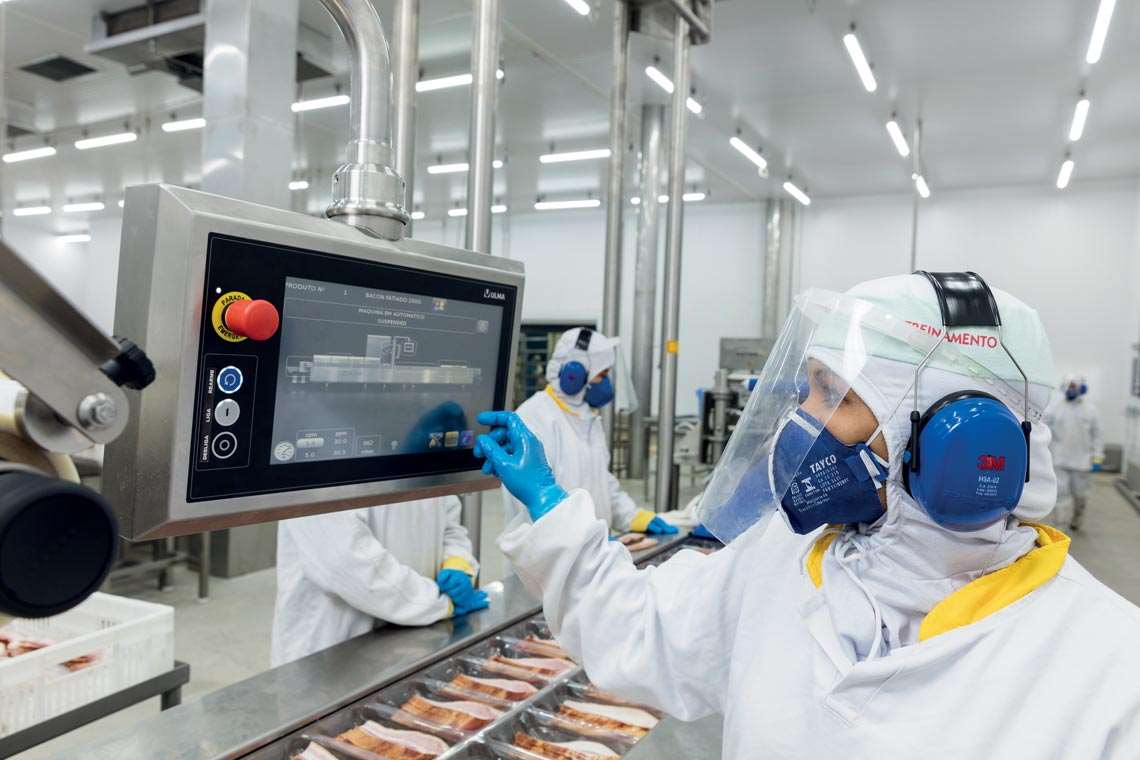In search of answers to the health, social, and economic crisis faced by the country since the arrival of COVID-19, researchers from different fields and higher education institutions have been establishing networks since March 2020 to improve dialogue with the public authorities and contribute to decision-making and the formulation of public policies. Pesquisa FAPESP identified at least 20 such initiatives working on a range of activities, from analyzing the impact of the SARS-CoV-2 virus on vulnerable populations to developing methodologies for tracking and anticipating the spread of different viruses, which could support the creation of containment measures.
– Obstacle course
– Breathless emerging economies
– The expected effect of vaccines
– Eurico Arruda: Admirer of viruses
“In the last year, we have seen a rising number of groups and associations analyzing and searching for accurate data about the pandemic as a means of increasing the transparency of information provided by the government,” says sociologist Glauco Arbix, from the School of Philosophy, Languages and Literature, and Humanities (FFLCH) at the University of São Paulo (USP). One example of this movement is the Solidary Research Network, created by humanities researchers from USP with the aim of collaborating to improve COVID-19 policies established by federal, state, and municipal authorities (see “Data hunters,” an interview with Lorena Barberia, on the Pesquisa FAPESP website). The network is just one of several initiatives created by USP researchers to collaborate in the fight against the pandemic. Today it comprises more than 100 experts, including political scientists, sociologists, doctors, engineers, economists, and anthropologists. “We have issued 26 technical statements in weekly newsletters distributed to more than 10,000 people,” says Arbix.
In addition to influencing public debate, the network has opened channels of dialogue with policymakers, meeting with members of the executive and legislative branches of the São Paulo and Rio Grande do Sul state governments, and liaising with the governors of Bahia and Maranhão. “The Mato Grosso do Sul Health Department asked the network about testing, which helped it to plan municipal containment measures,” he says. The group has also organized international seminars—one of which was attended by government ministers from Buenos Aires in Argentina and Bogotá in Colombia, as well as more than 3,000 online participants.
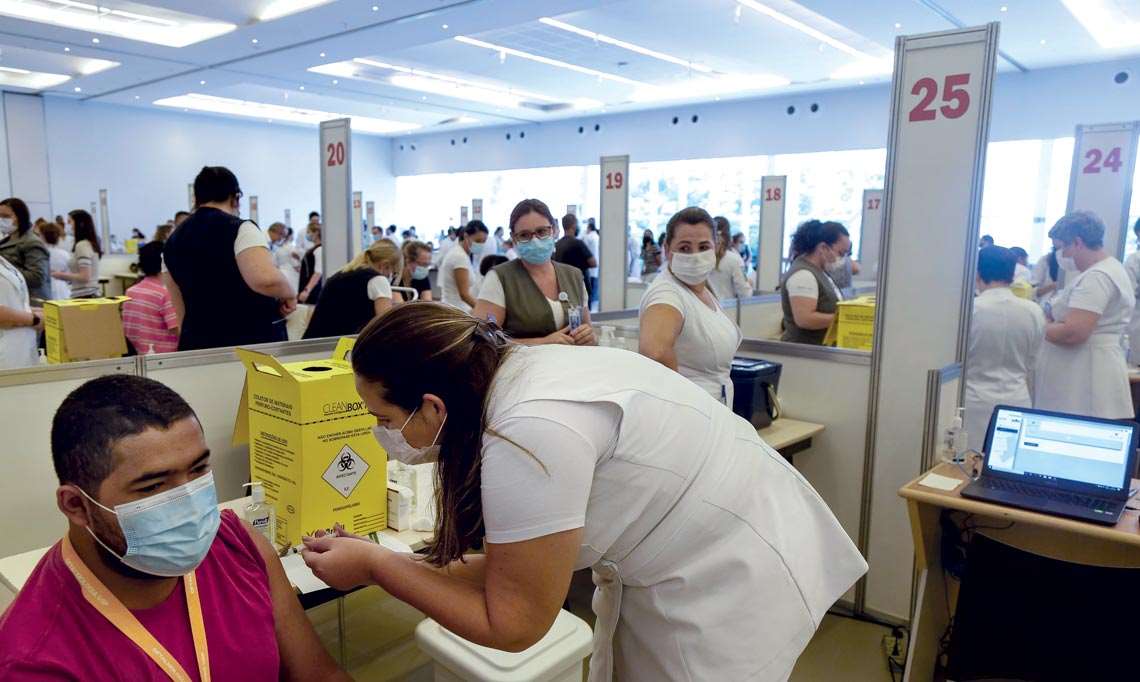
Health professionals prioritized by vaccination policies receive a dose of the vaccine at Hospital das Clínicas, USP, in early JanuaryMiguel Schincariol / Getty Images
Regarding access to knowledge produced in universities, Victor Borges, president of the Brazilian Network of Public Consortia of Municipalities, which has around 2,700 members from across the country, explains that since March 2020, online seminars involving researchers and public managers have been one of the best tools for helping local governments combat the pandemic. “Access to the results of scientific studies improves public policy making,” he emphasizes.
Most of the researchers from the Solidary Research Network take part on a voluntary basis. With funding from institutions such as the Betty and Jacob Lafer Institute, the Brazilian Center for Research and Planning (CEBRAP), the Ford Foundation, the Tide Setúbal Foundation, and several private companies, around 20 scholarships were awarded to undergraduate and graduate students who joined the project. This year, by offering a graduate course on pandemics that they hope will reach 1,000 students, and with funds provided by all four of USP’s Associate Dean’s Offices, the group intends to focus on vaccination, education, and sustainability, with debates scheduled to take place at São Paulo City Hall. The first bulletin published by the network this year argued that vaccination strategies should prioritize health workers, identifying which professions and locations are most important, by analyzing databases such as the National Accounts System and the National Continuous Household Sample Survey (Continuous PNAD), both run by the Brazilian Institute of Geography and Statistics (IBGE), as well as the National Register of Health Establishments (CNES) and information from professional councils (see infographic below).

While the Solidary Research Network takes a broad approach, seeking to influence policymaking nationwide, other interdisciplinary research networks have been created to support public managers in specific regions. Physician Carlos Magno Castelo Branco Fortaleza, from the School of Medicine (FM) at São Paulo State University (UNESP), Botucatu campus, for example, is part of a multidisciplinary group composed of health geographers, mathematicians, computer scientists, and cartographers that is studying the pandemic and proposing solutions for the interior of São Paulo State. In the first half of 2020, the group created Radar COVID-19, a project that mines and analyzes data and rumors from Twitter on the spread of the novel coronavirus in the state of São Paulo. “Over the past year, we monitored mentions of COVID-19 on the social network, identifying possible cases before they were officially notified by health surveillance systems,” explains Fortaleza. The group links the tweets with official data and Google searches to create maps indicating potential outbreaks and how the disease is spreading in the interior of the state. “We found that when COVID-19 arrived in Greater São Paulo, it spread like a tsunami to the wider metropolis, including Campinas and Baixada Santista, due to the pendulum movement of inhabitants between cities in the region,” says Fortaleza . The group also identified that the disease spread throughout the state of São Paulo along its major highways, mostly affecting regional capitals, such as Ribeirão Preto, Araçatuba, and Presidente Prudente, before reaching other highly connected municipalities, then those with fewer connections, and finally, rural areas. “When examining how the disease spread over time, we found that it was transmitted across the state based on the size hierarchy that exists between cities,” he explains. “The data was presented at meetings between our team and members of the state government. Our analyses influenced the containment policy implemented in the interior of São Paulo,” says Fortaleza, a member of the team that advises the São Paulo state government and suggests guidelines for combating the pandemic. The government adopted measures to control the disease in larger towns, for example, as a way of protecting smaller municipalities.
The results of the study conducted by Fortaleza and other UNESP researchcers were presented to municipal managers at a seminar organized by the Brazilian Network of Public Consortia of Municipalities in the first half of 2020. “The study of how COVID-19 spread through São Paulo indicated that we have to fight the pandemic as a network. It is not enough for isolated municipalities to takes precautionary measures alone. This information guided the containment plans of different towns and cities,” highlights Borges, from the network.
The pioneering initiative developed at UNESP led to a larger project. “We now intend to use data mining techniques to monitor early signs of pandemic situations on a global level. The idea is to identify whether large increases in mentions of the word fever in a given region, for example, or searches for antipyretics, are indications of the beginning of an outbreak,” explains Fortaleza. The initiative aims to provide data that can guide global epidemiological surveillance actions. “By identifying potential epidemic outbreaks in regions that are part of large flight networks, for example, we can issue alerts about the risk of a disease spreading quickly around the world,” highlights the researcher.
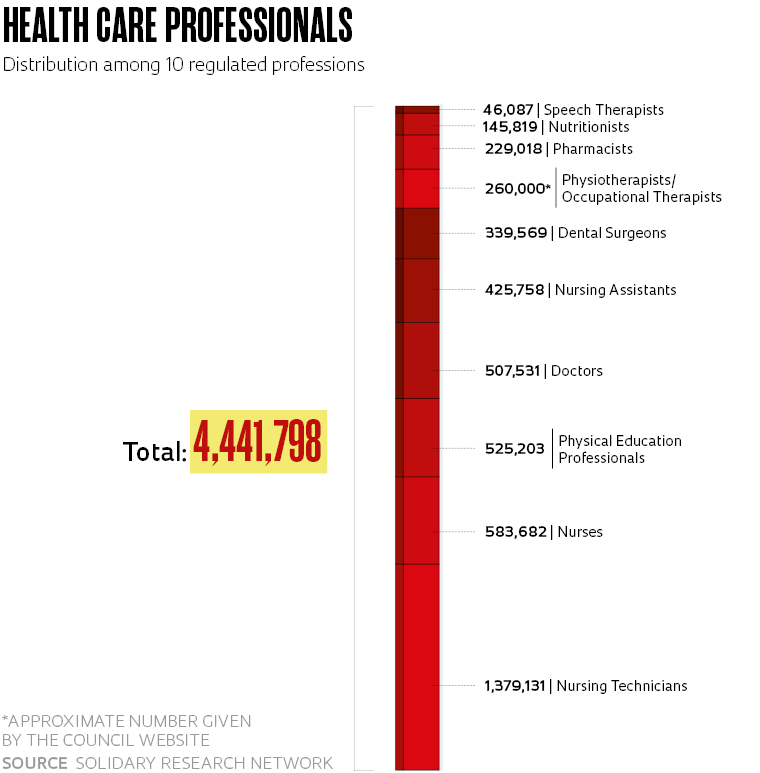
Like the Solidary Research Network, the UNESP project started a year ago as a voluntary initiative and in 2021 began to receive funding from private institutions, such as food company JBS and the Federation of Industries of the State of São Paulo (FIESP). “With these funds, we were able to purchase powerful computers for UNESP’S twin laboratories in Botucatu and Presidente Prudente, capable of mining data from all over the world,” says Fortaleza.
Fernando Meller, manager of a social program run by JBS called Fazer o Bem Faz Bem (“It’s good to do good”), explains that the company donated R$50 million to 39 scientific studies on COVID-19 in 15 states. “We set up a committee of medical and scientific professionals to define the investment criteria. The research projects are linked to public universities and research or health institutes,” he says, noting that the pandemic has brought together academics, businesses, and public managers. “The world is going through an unprecedented crisis that we all need to face together. Since the beginning of the pandemic, JBS has been dedicated to addressing critical issues in the countries in which it operates, seeking to leave a legacy for local communities,” he says.
Jorge Guimarães, CEO of the Brazilian Agency for Industrial Research and Innovation (EMBRAPII), believes Brazil is unprepared for emergency situations. According to him, the lack of preparation has been evident during this pandemic—in the biopharmaceutical sector, for example. “In the pharmaceutical industry, 95% of the ingredients for drugs manufactured domestically are imported. At the same time, Brazil has the sixth largest drug consumer market in the world,” he points out. “The pandemic revealed a historical problem: the low level of involvement among businesses in applied research, development, and innovation,” he laments, highlighting the country’s inability to produce inputs to produce the vaccine itself in the short term, while also noting its scientific, technological, and entrepreneurial competence. Marcio de Miranda Santos, CEO of the Center for Strategic Studies and Management (CGEE), also believes that the dialogue between academia and the public sector needs to improve, noting that decisions related to public health are not always made based on science. On the other hand, he sees the pandemic as a unique chance to strengthen the role of science in society. “We have never seen scientific work developed worldwide as fast as it is being now,” he points out.
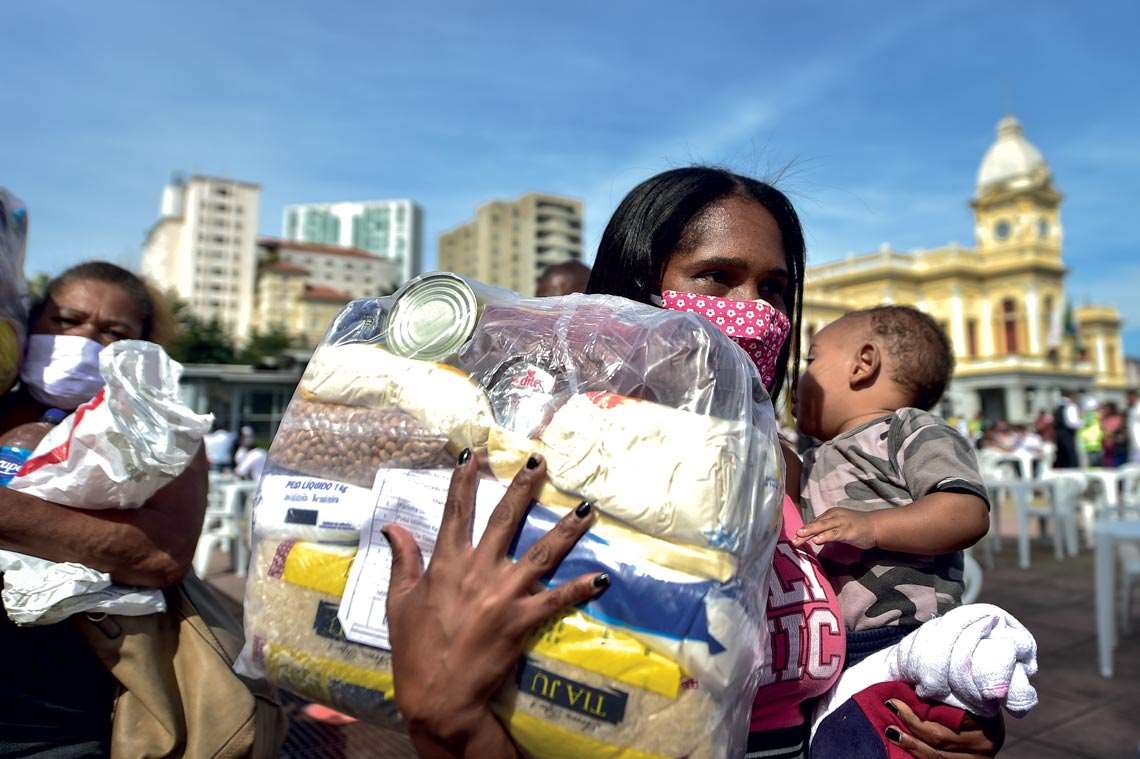
Woman carrying a basic food parcel in Belo Horizonte, Minas Gerais, given out by an initiative organized by a loan company: the pandemic has increased the private sector’s involvement in crisis managementPedro Vilela / Getty Images
Marcos Pacheco, Maranhão State Secretary for Public Policies, explains that in March 2020, one of the first measures the government took was to create an advisory committee of scientists. “We were the first capital in the country to declare a lockdown, at the suggestion of the committee,” he says. He explains that the Maranhão Foundation for Research and Scientific and Technological Development (FAPEMA) hired 100 students from the health sector to work at care units, triaging patients with symptoms of COVID-19. “This process of screening each patient before admission was essential to avoiding overcrowding and confusion in hospitals,” he says. Another measure implemented based on the committee’s guidelines was to invest in new beds for existing hospitals, instead of creating field hospitals. “As a result, when the pandemic is over, these beds can be used to treat patients with other illnesses, or even sequelae from COVID-19,” he says.
With funding from the private sector, Anthropologist Denise Nacif Pimenta, from the René Rachou Research Institute at the Oswaldo Cruz Foundation (FIOCRUZ) in Belo Horizonte, and Clare Wenham, from the London School of Economics (LSE) in England, help run the Gender & Covid-19 Network, an international research group studying gender issues related to the pandemic in a global context. “The group was formed based on a demand from the Bill & Melinda Gates Foundation, covering scholars from nine countries, including England, Japan, the USA, Bangladesh, South Africa, Brazil, and others,” explains Pimenta. According to her, the topic caught the attention of the foundation after an article was published by British, Canadian, and American researchers in the scientific journal The Lancet in March 2020, showing that despite the fact that COVID-19 is more deadly for men, the economic, social, and health impacts have more of an impact on women. Based on preliminary results obtained by the group of researchers in February this year, a document was published recommending how to consider gender issues when formulating public health policies.
Arbix, from USP, believes the lack of coordination between the federal, state, and municipal government when it comes to disseminating information and developing strategies to combat the pandemic has also encouraged the business sector to get involved. “In the last year, many companies have taken philanthropic action and begun supporting research for the public good, something never seen before in the country,” he says, citing as an example the donation of R$1 billion by Itaú to Todos pela Saúde, an initiative involving researchers from USP and FIOCRUZ.
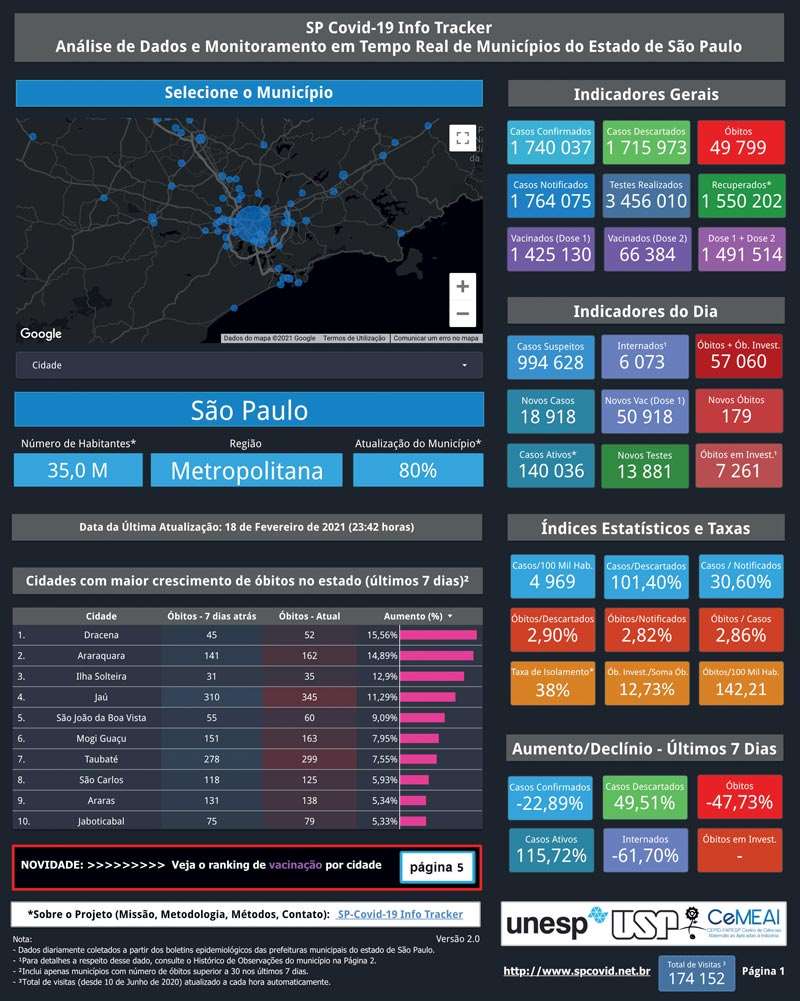
Info Tracker digital platform, which systematizes data on the spread of the disease and supports public managers in the interior of São Paulo State to develop containment strategiesReproduction
Dedicated to systematizing data on how the disease spreads, Info Tracker is a digital platform created in April 2020 by five mathematicians and computer scientists from UNESP, USP, and the Virtual University of the State of São Paulo (UNIVESP), three of whom are linked to the Center for Mathematical Sciences Applied to Industry (CEMEAI), one of the Research, Innovation, and Dissemination Centers (RIDCs) in the computational intelligence sector funded by FAPESP. The platform reports on the rate at which the virus is spreading, its reproduction number, and the transmission rate in the state of São Paulo and five other regions of Brazil. “We developed a methodology to make mathematical calculations using artificial intelligence, based on information collected by municipal governments,” explains mathematician Wallace Correa de Oliveira Casaca, from the Experimental de Rosana campus at UNESP. Casaca also works at CEMEAI, and explains that one of the center’s missions is to collaborate to resolve practical problems. Headquartered at USP’s São Carlos campus, the center coordinates with the demands of the local government. Dialogue with managers from other municipalities has expanded during the pandemic. The team behind the platform has been approached by managers from Limeira, Franca, and Presidente Prudente in the interior of São Paulo, seeking support to interpret data and better understand the epidemiological situation.
Systematizing and analyzing data to measure how intensely the virus is spreading in the country is also the objective of the Covid BR Observatory, comprised of 81 researchers, including doctors, biologists, mathematicians, and others. Using mathematical models and official data, the group models how the disease might spread, with the aim of collaborating with public planning agencies.
In response to an invitation by the Health Geographers Network, which includes researchers from all over Brazil, geographer Rivaldo Mauro de Faria of the Federal University of Santa Maria (UFSM) developed a project to map locations in the municipality that are more susceptible to proliferation of the virus. The aim is to give the city’s administration access to strategic information to help combat the pandemic in the context of social inequality. “Together with infectologists and epidemiologists, we started using geoprocessing software to monitor how Covid is spreading, to establish the locations of confirmed cases and deaths in real time,” says Faria. Unlike the other projects mentioned above, the UFSM initiative is being developed in conjunction with the Department of Health. This means the epidemiological surveillance actions taken by the municipality are based on the data collected. At first, the project hypothesized that mortality would be higher in Rio Grande do Sul than the rest of the country due to the large number of elderly inhabitants. The projection, however, turned out to be incorrect. “COVID-19’s mortality rate is more closely associated to the population’s living conditions, such as the existence of previous diseases and vulnerable ways of living,” says the geographer, who sees working in networks as fundamental to identifying the specifics of the pandemic in Rio Grande do Sul.
Public notices and calls for proposals have also led to the creation of networks. Funded by the Brazilian Ministry of Science, Technology, and Innovation (MCTI), the MCTI COVID-19 Humanities Network comprises more than 90 researchers—mostly anthropologists and sociologists—from 14 Brazilian states, investigating the social impacts of the pandemic on different populations. Project leader and anthropologist Jean Segata of the Federal University of Rio Grande do Sul (UFRGS) explains that at this point in time, the team is working on data collection so that in 2022, it can make policy recommendations for specific audiences in different regions of Brazil.
Among the populations being studied by the network are health professionals, the elderly, artists, rideshare and delivery app drivers, and slaughterhouse workers. “The pandemic has shown that public health policies in a country as diverse and unequal as Brazil need to take into account specific local factors,” stresses Segata. As an example, he mentions the universal recommendation to regularly wash hands and wear masks, which are practically impossible for people without access to clean water or the money needed to purchase basic necessities. Another example is social distancing and recommendations to stay at home, which despite being one of the most effective ways of combating COVID-19, is not feasible for essential service workers. “In the first six months of the pandemic, when social distancing was followed more strictly, there were about 6,000 recorded cases among people working at slaughterhouses, considered an essential service,” says the anthropologist. These cases represented 33% of infections in Rio Grande do Sul in that period. “We found that the meat industry was responsible for spreading the virus through the state, something could have been avoided by adopting specific policies for the sector,” he argues.
Emphasizing that the work of anthropologists is grounded in field research, Segata says that due to the need for social distancing, the team involved in the project is carrying out this part of the study through online communication platforms. “This has been an enormous challenge. The methodologies we are creating will provide new perspectives for anthropological studies in the years to come,” he predicts.
The anthropologist says the project intends to identify the experiences other specific groups have had with the virus in order to contribute to public policies for vulnerable populations. “The virus alone does not make a pandemic—that requires particular conditions and political practices that cause it to spread,” he notes. In addition to scholars from UFRGS, the network includes researchers from FIOCRUZ, the University of Campinas (UNICAMP), the University of Brasília (UnB), the University of Alto Vale do Itajaí (UNIDAVI), and the federal universities of Santa Catarina (UFSC) and Rio Grande do Norte (UFRN). “Conducting research as part of a network enables faster responses and is essential for issues related to the pandemic, which require multidisciplinary actions,” he says, adding that the project has received R$2 million in funding from MCTI, and is expected to continue until July 2022.
Another project resulting from a government call for proposals is creating an epidemiological COVID-19 map based on analyses of the sewage network in Santo André, in São Paulo’s ABC region. Biologist Rodrigo Bueno from the Center for Engineering, Modeling, and Applied Social Sciences (CECS) at the Federal University of ABC (UFABC) is head of the initiative and reveals that various points in the sewage network are being monitored, including regions of greater socioeconomic vulnerability, middle and upper class areas, sectors with a higher number of hospitals used to treat the disease, and areas with low-quality housing. Expected to last until June 2022, the project presupposes the creation of an Early Warning System for both COVID-19 and other pathogens. “Recent data from the study show that in the ABC region, the number of infected people is two to three times higher than the figures officially reported by the surveillance system. The difference can be explained by the fact that the study also identifies asymptomatic cases,” he says. He explains that the map is updated by weekly collections from the sewage network at the established points, which include everything from sewage treatment plants to structures located in specific neighborhoods. “The RNA of the COVID-19 virus is expelled in the feces of infected individuals, including asymptomatic individuals,” he explains. According to Bueno, a network of researchers from 12 institutions is being formed with the objective of permanently monitoring the sewage network. “We intend to work together with sanitation companies, health departments, and the Ministry of Health,” says Bueno.

…and delivery drivers are followed by research aiming to support the formulation of public policiesLéo Ramos Chaves
As part of a public call for proposals issued by the university for research related to the pandemic, sociologist and lawyer Alessandra Teixeira, also from CECS, led a study to identify services and agencies combating violence against women in the ABC region. “The system for confronting gender-based violence is deficient and fragmented. Information on the existence of specialist police services for women, shelters, support centers, and specific courts is dispersed and difficult to access,” comments Teixeira. As the result of a partnership between five university researchers, undergraduate and graduate students, and public organizations, the project prepared educational material with information about all of the institutions in this system in each of the seven municipalities of the ABC region. “As well as helping women understand the flow of assistance, we diagnose these networks in each city, identifying where problems lie and proposing improvements,” explains the sociologist. Since the end of last year, the educational material has been available at the institutions themselves and at the headquarters of public organizations.
Research networks were also formed to analyze public policies designed to fight the pandemic. Led by Cornell and Harvard in the USA, a study is comparing government responses related to public health, economics, and politics during the pandemic in 16 countries, including Brazil. Anthropologist Marko Monteiro and PhD researcher Alberto Urbinatti, from the Institute of Geosciences (IG) at the University of Campinas (UNICAMP), also participated in the project, which was funded by the US National Science Foundation (NSF) and Schmidt Futures, a private American institution that seeks to bridge the gap between science and public policy. With a similar proposal, the School of Business Administration (EAESP) at the Getúlio Vargas Foundation (FGV) is analyzing the COVID-19 response pattern of different countries and health systems. In the case of Brazil, the contingency plans adopted by states and municipalities and their impact on health care structures are being studied.

An epidemiological map of COVID-19 based on analysis of the sewage network in Santo André, São Paulo, can identify asymptomatic casesVitor Mazuco / Wikimedia Commons
Borges, from the National Network of Public Consortia of Municipalities, highlights areas where partnerships between public managers and academia are needed, including the treatment of other diseases that have been delayed due to the current health crisis. “It will be essential to conduct studies that help municipalities organize and plan for the treatment of these diseases,” he says. Another area is education. “The absence of in-person classes has primarily affected students from underprivileged regions with low internet access. We need academia to help us understand how to compensate for the learning they have missed out on,” he concludes.
Project
CEMEAI – Center for Mathematical Sciences Applied to Industry (no. 13/07375-0); Grant Mechanism Research, Innovation, and Dissemination Center (RIDC); Principal Investigator José Alberto Cuminato (USP); Investment R$40,636,964.70.
Scientific article
WENHAM, C. et al. Covid-19: The gendered impacts of the outbreak. The Lancet. pp. 846–848. Mar. 2020.
Document
ROSSER, E. N. et al. How to create a gender-responsive pandemic plan: Addressing the secondary effects of Covid-19. Gender and Covid-19 Project.
